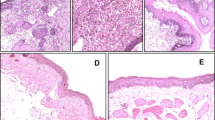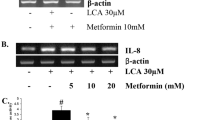Abstract
We have recently shown that aldose reductase (AR, EC 1.1.1.21) a nicotinamide adenine dinucleotide phosphate-dependent aldo–keto reductase, known to be involved in oxidative stress-signaling, prevents human colon cancer cell growth in culture as well as in nude mice xenografts. Inhibition of AR also prevents azoxymethane-induced aberrant crypt foci formation in mice. In order to understand the chemopreventive mechanism(s) of AR inhibition in colon cancer, we have investigated the role of AR in the mediation of angiogenic signals in vitro and in vivo models. Our results show that inhibition of AR significantly prevented the VEGF- and FGF -induced proliferation and expression of proliferative marker Ki67 in the human umbilical vein endothelial cells (HUVEC). Further, AR inhibition or ablation with siRNA prevented the VEGF- and FGF –induced invasion and migration in HUVEC. AR inhibition also prevented the VEGF- and FGF- induced secretion/expression of IL-6, MMP2, MMP9, ICAM, and VCAM. The anti-angiogenic feature of AR inhibition in HUVEC was associated with inactivation of PI3 K/AKT and NF-κB (p65) and suppression of VEGF receptor 2 protein levels. Most importantly, matrigel plug model of angiogenesis in rats showed that inhibition of AR prevented infiltration of blood cells, invasion, migration and formation of capillary like structures, and expression of blood vessels markers CD31 and vWF. Thus, our results demonstrate that AR inhibitors could be novel agents to prevent angiogenesis.






Similar content being viewed by others
Abbreviations
- AP1:
-
Activator protein
- AR:
-
Aldose reductase
- DHN:
-
1,4-dihydroxynonene
- FGF:
-
Basic fibroblast growth factor
- Fid:
-
Fidarestat
- GSH:
-
Glutathione
- GS-HNE:
-
Glutathionyl-4-hydroxynonenal
- GS-DHN:
-
Glutathionyl-1,4-dihydroxynonene
- HNE:
-
4-hydroxy-trans-2-nonenal
- HUVEC:
-
Human umbilical vascular endothelial cells
- MMP:
-
Matrix metalloproteinases
- MTT:
-
3-(4,5-dimethylthiazol-2-yl)-2,5-diphenyltetrazolium bromide
- NF-κB:
-
Nuclear factor kappa B
- ROS:
-
Reactive oxygen species
- siRNA:
-
Small interfering RNA
- VEGF:
-
Vascular endothelial growth factor
- VSMC:
-
Vascular smooth muscle cells
- vWF:
-
Von-Willebrand factor
References
Ferrara N, Kerbel RS (2005) Angiogenesis as a therapeutic target. Nature 438:967–974
Chiodoni C, Colombo MP, Sangaletti S (2010) Matricellular proteins: from homeostasis to inflammation, cancer, and metastasis. Cancer Metastasis Rev 29:295–307
Carmeliet P (2005) Angiogenesis in life, disease and medicine. Nature 438:932–936
Jamie MH, Stacey LB, Jason EB (2008) Comparison of angiogenesis-related factor expression in primary tumor cultures under normal and hypoxic growth conditions. Cancer Cell International 8:11
Ben-Baruch A (2003) Host microenvironment in breast cancer development. Inflammatory cells, cytokines and chemokines in breast cancer progression: reciprocal tumor–microenvironment interactions. Breast Cancer Res 5:31–36
Ann H, Bart L, Martin S, Highley H, Wildiers AT, Van O, Ernst A, Bruijn D (2004) Vascular Endothelial Growth Factor and Angiogenesis. Pharmacol Rev 56:549–580
Reuter S, Gupta SC, Chaturvedi MM, Aggarwal BB (2010) Oxidative stress, inflammation, and cancer: How are they linked? Free Radic Biol Med 49:1603–1616
Chan EC, Jiang F, Peshavariya HM, Dusting GJ (2009) Regulation of cell proliferation by NADPH oxidase-mediated signaling: potential roles in tissue repair, regenerative medicine and tissue engineering. Pharmacol Ther 122:97–108
Bräsen JH, Kivelä A, Röser K, Rissanen TT, Niemi M, Luft FC, Donath K, Ylä-Herttuala S (2001) Angiogenesis, vascular endothelial growth factor and platelet-derived growth factor-BB expression, iron deposition, and oxidation-specific epitopes in stented human coronary arteries. Arterioscler Thromb Vasc Biol 21:1720–1726
Edirisinghe I, Rahman I (2010) Cigarette smoke-mediated oxidative stress, shear stress, and endothelial dysfunction: role of VEGFR2. Ann N Y Acad Sci 1203:66–72
Rabbani ZN, Mi J, Zhang Y, Delong M, Jackson IL, Fleckenstein K, Salahuddin FK, Zhang X, Clary B, Anscher MS, Vujaskovic Z (2010) Hypoxia inducible factor 1alpha signaling in fractionated radiation-induced lung injury: role of oxidative stress and tissue hypoxia. Radiat Res 173:165–174
Yang Z, Li C, Wang X, Zhai C, Yi Z, Wang L, Liu B, Du B, Wu H, Guo X, Liu M, Li D, Luo J (2010) Dauricine induces apoptosis, inhibits proliferation and invasion through inhibiting NF-kappaB signaling pathway in colon cancer cells. J Cell Physiol 225:266–275
Cezar-de-Mello PF, Vieira AM, Nascimento-Silva V, Villela CG, Barja-Fidalgo C, Fierro IM (2008) ATL-1, an analogue of aspirin-triggered lipoxin A4, is a potent inhibitor of several steps in angiogenesis induced by vascular endothelial growth factor. Br J Pharmacol 153:956–965
Wu WS (2006) The signaling mechanism of ROS in tumor progression. Cancer Metastasis Rev 25:695–705
Borek C (2004) Dietary antioxidants and human cancer. Integr Cancer Ther 3:333–341
Rajamanickam S, Velmurugan B, Kaur M, Singh RP, Agarwal R (2010) Chemoprevention of intestinal tumorigenesis in APCmin/+ mice by silibinin. Cancer Res 70:2368–2378
Fuggetta MP, Lanzilli G, Tricarico M, Cottarelli A, Falchetti R, Ravagnan G, Bonmassar E (2006) Effect of resveratrol on proliferation and telomerase activity of human colon cancer cells in vitro. J Exp Clin Cancer Res 25:189–193
Singh SV, Powolny AA, Stan SD, **ao D, Arlotti JA, Warin R, Hahm ER, Marynowski SW, Bommareddy A, Potter DM, Dhir R (2008) Garlic constituent diallyl trisulfide prevents development of poorly differentiated prostate cancer and pulmonary metastasis multiplicity in TRAMP mice. Cancer Res 68:9503–9511
Cao Y, Cao R (1999) Angiogenesis inhibited by drinking tea. Nature 398:381
Ramana KV, Bhatnagar A, Srivastava SK (2004) Aldose reductase regulates TNF-alpha-induced cell signaling and apoptosis in vascular endothelial cells. FEBS Lett 570:189–194
Chandra D, Ramana KV, Friedrich B, Srivastava S, Bhatnagar A, Srivastava SK (2003) Role of aldose reductase in TNF-alpha-induced apoptosis of vascular endothelial cells. Chem Biol Interact 143–144:605–612
Tammali R, Ramana KV, Singhal SS, Awasthi S, Srivastava SK (2006) Aldose reductase regulates growth factor-induced cyclooxygenase-2 expression and prostaglandin E2 production in human colon cancer cells. Cancer Res 66:9705–9713
Tammali R, Ramana KV, Srivastava SK (2007) Aldose reductase regulates TNF-alpha-induced PGE2 production in human colon cancer cells. Cancer Lett 252:299–306
Srivastava SK, Ramana KV, Bhatnagar A (2005) Role of aldose reductase and oxidative damage in diabetes and the consequent potential for therapeutic options. Endocr Rev 26:380–392
Ramana KV, Chandra D, Srivastava S, Bhatnagar A, Aggarwal BB, Srivastava SK (2002) Aldose reductase mediates mitogenic signaling in vascular smooth muscle cells. J Biol Chem 277:32063–32070
Ramana KV, Willis MS, White MD, Horton JW, DiMaio JM, Srivastava D, Bhatnagar A, Srivastava SK (2006) Endotoxin-induced cardiomyopathy and systemic inflammation in mice is prevented by aldose reductase inhibition. Circulation 114:1838–1846
Ramana KV, Bhatnagar A, Srivastava S, Yadav UC, Awasthi S, Awasthi YC, Srivastava SK (2006) Mitogenic responses of vascular smooth muscle cells to lipid peroxidation-derived aldehyde 4-hydroxy-trans-2-nonenal (HNE): role of aldose reductase-catalyzed reduction of the HNE-glutathione conjugates in regulating cell growth. J Biol Chem 281:17652–17660
Ramana KV, Tammali R, Srivastava SK (2010) Inhibition of aldose reductase prevents growth factor-induced G1-S phase transition through the AKT/phosphoinositide 3-kinase/E2F–1 pathway in human colon cancer cells. Mol Cancer Ther 9:813–824
Tammali R, Reddy AB, Ramana KV, Petrash JM, Srivastava SK (2009) Aldose reductase deficiency in mice prevents azoxymethane-induced colonic preneoplastic aberrant crypt foci formation. Carcinogenesis 30:799–807
Salani D, Taraboletti G, Rosanò L, Di Castro V, Borsotti P, Giavazzi R, Bagnato A (2000) Endothelin-1 induces an angiogenic phenotype in cultured endothelial cells and stimulates neovascularization in vivo. Am J Pathol 157:1703–1711
Burger M, Hartmann T, Burger JA, Schraufstatter I (2005) KSHV-GPCR and CXCR2 transforming capacity and angiogenic responses are mediated through a JAK2-STAT3-dependent pathway. Oncogene 24:2067–2075
Karkoulis PK, Stravopodis DJ, Margaritis LH, Voutsinas GE (2010) 17-Allylamino-17-demethoxygeldanamycin induces downregulation of critical Hsp90 protein clients and results in cell cycle arrest and apoptosis of human urinary bladder cancer cells. BMC Cancer 10:481
Pang X, Yi Z, Zhang J, Lu B, Sung B, Qu W, Aggarwal BB, Liu M (2010) Celastrol suppresses angiogenesis-mediated tumor growth through inhibition of AKT/mammalian target of rapamycin pathway. Cancer Res 70:1951–1959
Jiang BH, Zheng JZ, Aoki M, Vogt PK (2000) Phosphatidylinositol 3-kinase signaling mediates angiogenesis and expression of vascular endothelial growth factor in endothelial cells. Proc Natl Acad Sci USA 97:1749–1753
Brader S, Eccles SA (2004) Phosphoinositide 3-kinase signalling pathways in tumor progression, invasion and angiogenesis. Tumori 90:2–8
**ao D, Li M, Herman-Antosiewicz A, Antosiewicz J, **ao H, Lew KL, Zeng Y, Marynowski SW, Singh SV (2006) Diallyl trisulfide inhibits angiogenic features of human umbilical vein endothelial cells by causing Akt inactivation and down-regulation of VEGF and VEGF-R2. Nutr Cancer 55:94–107
Shono T, Ono M, Izumi H, Jimi SI, Matsushima K, Okamoto T, Kohno K, Kuwano M (1996) Involvement of the transcription factor NF-kB in tubular morphogenesis of human microvascular endothelial cells by oxidative stress. Mol Cell Biol 16:4231–4239
Morais C, Gobe G, Johnson DW, Healy H (2009) Anti-angiogenic actions of pyrrolidine dithiocarbamate, a nuclear factor kappa B inhibitor. Angiogenesis 12:365–379
Tabruyn SP, Mémet S, Avé P, Verhaeghe C, Mayo KH, Struman I, Martial JA, Griffioen AW (2009) NF-kappaB activation in endothelial cells is critical for the activity of angiostatic agents. Mol Cancer Ther 8:2645–2654
Nijmeh J, Moldobaeva A, Wagner EM (2010) Role of ROS in ischemia-induced lung angiogenesis. Am J Physiol Lung Cell Mol Physiol 299:L535–L541
Yasuda M, Ohzeki Y, Shimizu S, Naito S, Ohtsuru A, Yamamoto T, Kuroiwa Y (1999) Stimulation of in vitro angiogenesis by hydrogen peroxide and the relation with ETS-1 in endothelial cells. Life Sci 64:249–258
Schafer G, Cramer T, Suske G, Kemmner W, Wiedenmann B, Hocker M (2003) Oxidative stress regulates vascular endothelial growth factor-A gene transcription through Sp1- and Sp3-dependent activation of two proximal GC-rich promoter elements. J Biol Chem 278:8190–8198
Ramana KV, Fadl AA, Tammali R, Reddy AB, Chopra AK, Srivastava SK (2006) Aldose reductase mediates the lipopolysaccharide-induced release of inflammatory mediators in RAW264.7 murine macrophages. J Biol Chem 281:33019–33029
Obrosova IG, Minchenko AG, Vasupuram R, White L, Abatan OI, Kumagai AK, Frank RN, Stevens MJ (2003) Aldose reductase inhibitor fidarestat prevents retinal oxidative stress and vascular endothelial growth factor overexpression in streptozotocin-diabetic rats. Diabetes 52:864–871
Hamuro M, Polan J, Natarajan M, Mohan S (2002) High glucose induced nuclear factor kappa B mediated inhibition of endothelial cell migration. Atherosclerosis. 162:277–287
D’Souza DR, Salib MM, Bennett J, Mochin-Peters M, Asrani K, Goldblum SE, Renoud KJ, Shapiro P, Passaniti A (2009) Hyperglycemia regulates RUNX2 activation and cellular wound healing through the aldose reductase polyol pathway. J Biol Chem. 284(27):17947–17955
Shiojima I, Walsh K (2002) Role of Akt signaling in vascular homeostasis and angiogenesis. Circ Res 90:1243–1250
Numasaki M, Watanabe M, Suzuki T, Takahashi H, Nakamura A, McAllister F, Hishinuma T, Goto J, Lotze MT, Kolls JK, Sasaki H (2005) IL-17 enhances the net angiogenic activity and in vivo growth of human non-small cell lung cancer in SCID mice through promoting CXCR-2-dependent angiogenesis. J Immunol 175:6177–6189
Goette A, Wolfram O, Jentsch-Ullrich K, Martens-Lobenhoffer J, Scalera F, Lendeckel U, Bode-Böger SM (2010) The effects of G-CSF-induced mobilization of progenitor cells are limited by ADMA. Int J Cardiol 143:264–270
Liu H, Chen B, Lilly B (2008) Fibroblasts potentiate blood vessel formation partially through secreted factor TIMP-1. Angiogenesis 11:223–234
Gloire G, Legrand-Poels S, Piette J (2006) NF-kappaB activation by reactive oxygen species: fifteen years later. Biochem Pharmacol 72:1493–1505
**ao D, Singh SV (2007) Phenethyl isothiocyanate inhibits angiogenesis in vitro and ex vivo. Cancer Res 67:2239–2246
Acknowledgments
Supported by in parts by NIH grants CA129383 and DK36118 (SKS) and GM71036 (KVR). Satish Srivastava is a William Bowes Senior Fellow of the American Asthma Foundation.
Author information
Authors and Affiliations
Corresponding author
Additional information
R. Tammali and A. B. M. Reddy have contributed equally to this work.
Rights and permissions
About this article
Cite this article
Tammali, R., Reddy, A.B.M., Srivastava, S.K. et al. Inhibition of aldose reductase prevents angiogenesis in vitro and in vivo. Angiogenesis 14, 209–221 (2011). https://doi.org/10.1007/s10456-011-9206-4
Received:
Accepted:
Published:
Issue Date:
DOI: https://doi.org/10.1007/s10456-011-9206-4




